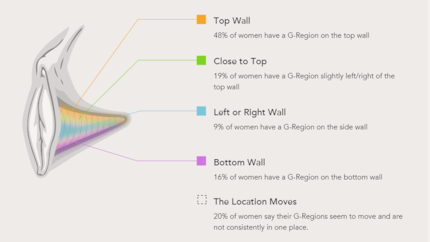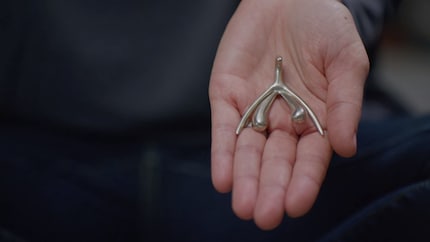
Guide
Do it yourself: fantastic facts about masturbation
by Janina Lebiszczak

Female pleasure is a mystery not only to men, but often to us women too. Complexity is often confused with unfathomability, which is why for a long time this area was not the subject of much research. That's slowly changing. The result? A series of breakthroughs.
Natalie and I are in our twenties and sexually literate women. We talk about sex. With our friends. In our relationship. Together. And yet, there's a lot we apparently don't know about female pleasure. By browsing OMGyes.com, a website dedicated to female sexuality, and watching explanatory Netflix series like "explained", we've both had a few triggers. We're learning totally new things about our bodies.
During the orgasm, the clitoris becomes more sensitive, so that, from one second to the next, a touch can be perceived as painful. With the end of the rhythmic contractions of the pelvic muscles, the orgasm also ends. The final phase consists of relaxing (or regaining orgasm). At this point, the clitoris is hypersensitive and the risk of pain from further contact is high.
The name leads to confusion. The G-spot is not a magic spot somewhere in your vagina. It's an area. And this area is only awakened by arousal - in the rising phase, the approach or sometimes even only after an orgasm. According to OMGyes, 45% of women found G-spot stimulation unpleasant at first, but then found ways to make it pleasurable.
My life in a nutshell? On a quest to broaden my horizon. I love discovering and learning new skills and I see a chance to experience something new in everything – be it travelling, reading, cooking, movies or DIY.
Practical solutions for everyday problems with technology, household hacks and much more.
Show allHave you ever wondered why certain touches are pleasurable for women at one moment and totally unpleasant at another? It may be due to the different phases of pleasure. Depending on the situation she finds herself in, her needs and perception change. Of course, every body is different. However, according to OMGyes, most women go through the same basic stages of pleasure. The transitions are not clearly defined and, from one person to another, entire phases can even be skipped.
In the first phase, it's all about increasing desire using, among other things, touch. At this stage, many women prefer caresses and the omission of particularly sensitive areas. Then follows the preliminary phase; a gradual increase in arousal, towards the longest phase: the ascending phase. In the next phase, known as the approaching phase, women feel for the first time that an orgasm is building inside them. For many, the slightest change in technique, rhythm or otherwise can lead to the "loss" of arousal.

As with most forms of desire and sexuality, there is no magic bullet that works for all women. However, certain trends do emerge from studies and surveys. The G-spot, or rather the G-zone, can be on the side, top or bottom of your vagina. It can be just behind the entrance or even a whole finger inside. OMGyes surveys have shown that in 48% of women, the G-zone is located at the top of the vaginal wall. In terms of depth, 37% say they penetrate as deeply as possible with their finger. These figures may help with research, but ultimately it's a journey of discovery that each woman must undertake alone or with her partner.
When we talk about the clitoris, many people immediately think of the little round bump at the top of the vulva. When it's actually just the glans of the clitoris. It protrudes from the foreskin and is just one part of the organ of pleasure, in which 8,000 nerve endings meet. The rest is hidden, particularly towards the back, around the vagina. This clitoral system is made up of two external pillars and two internal corpora cavernosa. So, as a woman, you have the same amount of corpora cavernosa as a man, except that your arousal takes place mainly in secret. According to the Netflix documentary series "explained" and "the goop lab", the actual size of the clitoris was not discovered untilwas only discovered in 1998 by Australian urologist Helen O'Connell, who dissected ten female cadavers. In 2005, she became the first scientist to map the entire structure of the clitoris using MRI images of living subjects.

Female ejaculation, known as squirting in English, is a mystery to many. Do all women manage it? Can it be learned? Does it even exist? The answer to the last question is: yes. Female ejaculation is not a myth, but the reality for 41% of participants in an American study. For many years, many of them didn't know they could ejaculate at all. Because for many women, this technique triggers an unpleasant and unusual sensation. It's as if they suddenly had to go to the toilet. But when they let go, many women describe squirting as a feeling of total liberation. It's a common misconception that ejaculation and orgasm are one and the same. But reality shows that only 20% also reach orgasm during ejaculation.
Two orgasms at the same time? This may seem unreal, as only 18% of women report having an orgasm solely through penetration. The rest require stimulation of the clitoris. And that's exactly what you add to sex to have two different orgasms at the same time. 30% of women claim to have had an internal and external orgasm at the same time - also known as a "blended orgasm". But even without this experience, including the glans of the clitoris during intercourse is well worth the effort. In fact, the combination of vaginal and clitoral stimulation leads to greater pleasure and more intense orgasms in many women.
Other women around us find themselves in the same situation as Nati and me. We are all constantly surprised by facts and experiences. There's so much we don't know about our bodies. And no wonder: female pleasure is an area that hasn't been researched very much yet. The subject is often pigeon-holed with the phrase "Every woman is different". Yes, female sexuality is multifaceted and complex, but it's not unfathomable or incomprehensible. Platforms like OMGyes or Netflix series like "Lab Goop" and "explained" show this, as do our conversations with friends.